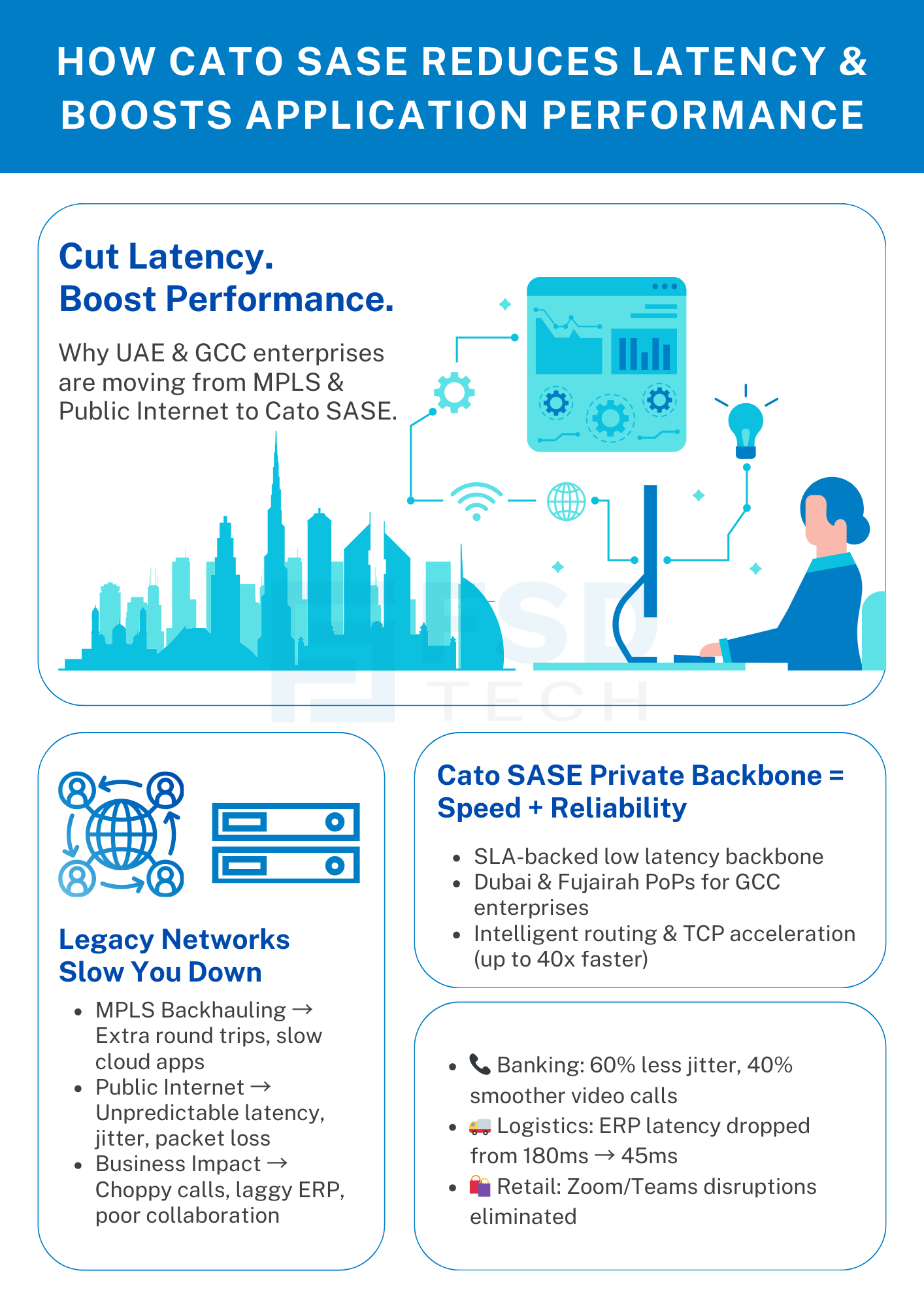
Inside Cato’s SASE Architecture: A Blueprint for Modern Security
🕓 January 26, 2025

Enterprise networks in the UAE, Dubai, and GCC are under mounting pressure as business applications migrate to the cloud and workforces become increasingly distributed. Yet, many organizations still rely on legacy MPLS circuits or Internet-based SD-WAN solutions to connect offices, data centers, and remote users.
These legacy approaches introduce substantial performance challenges:
For industries like banking, logistics, retail, energy, and real estate—where real-time data, collaboration, and customer experience are paramount—these issues can directly impact productivity, user satisfaction, and business outcomes.
Latency, jitter, and packet loss are not just technical metrics—they are critical to business success:
Real-World Example:
A multinational bank in Dubai observed that a mere 50ms increase in latency led to a 30% spike in VoIP call complaints and a measurable decline in customer service satisfaction. For remote-first teams and distributed branches, these performance issues are magnified, making legacy architectures increasingly untenable.
Is your enterprise struggling with latency or jitter? Get a free network performance assessment from FSD Tech. Click Here
Cato Networks redefines enterprise connectivity with its global private backbone—a dedicated, SLA-backed network spanning more than 85 Points of Presence (PoPs) worldwide. This architecture fundamentally changes how enterprise traffic traverses the globe:
| Legacy MPLS/Public Internet | Cato SASE Private Backbone |
|---|---|
| Centralized backhauling | Direct, local PoP access |
| Unpredictable latency | SLA-backed low latency |
| Congestion-prone | Congestion-free links |
| Complex, costly upgrades | Cloud-native scalability |
Case in Point:
A regional logistics provider operating in Dubai and Jeddah saw ERP response times drop from 180ms to 45ms after migrating to Cato SASE, enabling real-time inventory updates and smoother supply chain coordination.
Cato’s architecture is built for intelligent, application-aware traffic management:
Real-World Example:
A retail chain’s remote-first teams in the UAE and Oman experienced frequent Teams and Zoom disruptions. After deploying Cato SASE, packet loss was virtually eliminated, and collaboration tools became as responsive as on-premises applications.
Cato SASE is more than a fast network—it’s a secure, unified platform:
This convergence of security and networking is especially valuable for organizations in regulated industries or those with strict compliance requirements in the GCC.
The recent expansion of Cato’s private backbone into Dubai and Fujairah is a pivotal development for enterprises in the UAE and GCC. These local PoPs bring the backbone closer to users, minimizing the physical distance data must travel and dramatically reducing round-trip times.
Key Benefits for Regional Enterprises:
Case Study: Banking in the GCC
A multinational bank with branches in Dubai, Abu Dhabi, and Riyadh migrated to Cato SASE via FSD Tech. The result: a 60% reduction in call jitter and a 40% improvement in video meeting stability, thanks to direct routing through the Dubai PoP.
Prior to Cato SASE, the bank’s VoIP and video calls suffered from frequent drops and lag due to MPLS backhauling and public Internet congestion. Post-migration, calls were routed through the Dubai PoP, leveraging the private backbone for end-to-end quality of service. Call clarity improved, dropped calls became rare, and customer-facing teams reported a dramatic boost in productivity.
A logistics firm with warehouses in Fujairah and Jeddah required real-time cloud ERP access for inventory management. With Cato SASE’s private backbone and regional PoPs, ERP latency dropped from 180ms to 45ms, enabling instant updates and smoother operations. The IT team could now support just-in-time logistics and rapid order fulfillment, giving the company a competitive edge.
A leading retail chain with distributed teams in the UAE and Oman struggled with frequent disruptions in Microsoft Teams and Zoom. After deploying Cato SASE, packet loss was virtually eliminated, and collaboration tools became as responsive as on-premises applications, enabling seamless communication and faster decision-making.
Discover how Dubai & Fujairah PoPs can transform your enterprise connectivity. Request your tailored assessment today
Deploying a next-generation SASE solution is a strategic move. FSD Tech, as Cato’s regional partner, brings deep local knowledge and hands-on expertise to every deployment:
1. Discovery & Planning: Map current network, identify latency bottlenecks, and define business priorities.
2. Design & Integration: Architect a Cato SASE solution leveraging Dubai and Fujairah PoPs for optimal coverage.
3. Pilot & Migration: Roll out to key sites and remote users, monitor performance, and iterate.
4. Full Deployment: Expand across the enterprise, decommission legacy circuits, and optimize for ongoing needs.
5. Support & Optimization: FSD Tech provides 24/7 support, proactive monitoring, and regular performance reviews.
What This Means for CIOs:
With FSD Tech’s regional expertise, enterprises in the UAE and GCC can accelerate digital transformation, reduce risk, and ensure that network modernization projects deliver measurable business value from day one.
Ready to modernize your GCC network with Cato SASE? Book a strategy session with FSD Tech’s experts now.

Cato SASE routes enterprise traffic over its global private backbone, bypassing the unpredictable public Internet and eliminating MPLS backhauling delays. This approach delivers consistently lower latency and jitter, as traffic is always routed through the most optimal, SLA-backed path between Points of Presence (PoPs), including new regional PoPs in Dubai and Fujairah.
Real-time and bandwidth-sensitive applications—such as VoIP, video conferencing, cloud ERP, and SaaS tools—see the greatest performance improvements. These applications are particularly sensitive to latency, jitter, and packet loss, which Cato SASE is designed to minimize.
The addition of Dubai and Fujairah PoPs brings Cato’s private backbone closer to users in the UAE and GCC. This reduces round-trip time, improves application responsiveness, and supports regional compliance and resilience, making it ideal for industries with strict data residency and performance requirements.
FSD Tech acts as the regional enabler for Cato SASE, providing local expertise for deployment, integration, and ongoing optimization. Their deep understanding of GCC enterprise requirements ensures that organizations realize the full benefits of Cato’s platform, from planning through to continuous support.
Migration is designed to be seamless and can be phased to minimize disruption. FSD Tech’s support and Cato’s flexible architecture allow enterprises to transition at their own pace, often running both networks in parallel before fully decommissioning legacy circuits.
Cato SASE converges networking and security into a single, cloud-native software stack. Security functions such as firewall, secure web gateway, and zero trust access are integrated directly into the backbone, ensuring robust protection without introducing additional hops or delays.
Yes, Cato SASE is built for modern, distributed workforces. Its global backbone and intelligent routing ensure that remote and hybrid users experience the same low-latency, high-performance connectivity as users in corporate offices, regardless of location.
IT teams benefit from simplified management, reduced operational overhead, and unified visibility across networking and security. The cloud-native platform allows for rapid scaling, centralized policy enforcement, and proactive monitoring, freeing up resources for strategic initiatives.
While SD-WAN improves local breakout and routing, it still relies on the public Internet for the “middle mile,” which is prone to congestion and unpredictability. Cato SASE replaces this with a private backbone, delivering superior performance, reliability, and security.
Cato SASE’s regional PoPs enable local routing, supporting compliance with data residency and sovereignty requirements common in the GCC. This is particularly important for banking, government, and regulated industries.
FSD Tech follows a structured approach: discovery and planning, design and integration, pilot and migration, full deployment, and ongoing support. Their local expertise ensures that each phase is tailored to the unique needs of UAE and GCC enterprises, with minimal risk and maximum impact.
Enterprises typically see significant reductions in latency, jitter, and packet loss. For example, organizations have reported up to a 60% reduction in call jitter and a 40% improvement in video conferencing stability after migrating to Cato SASE via FSD Tech.
Absolutely. The SLA-backed backbone, regional redundancy via multiple PoPs, and integrated security make Cato SASE ideal for industries where uptime, resilience, and business continuity are non-negotiable.
Cato’s intelligent routing and TCP acceleration ensure that SaaS and cloud application traffic always takes the fastest, most reliable path. This results in faster page loads, smoother collaboration, and improved end-user satisfaction.
FSD Tech provides 24/7 support, proactive monitoring, and regular performance reviews for Cato SASE customers in the GCC. Their local presence ensures rapid response and tailored solutions for evolving business needs.
Enterprises can engage FSD Tech for an initial assessment and consultation. FSD Tech will map the current network, identify latency and performance bottlenecks, and design a phased migration plan leveraging Cato’s regional PoPs for maximum benefit.

Anas is an Expert in Network and Security Infrastructure, With over seven years of industry experience, holding certifications Including CCIE- Enterprise, PCNSE, Cato SASE Expert, and Atera Certified Master. Anas provides his valuable insights and expertise to readers.
Share it with friends!
share your thoughts